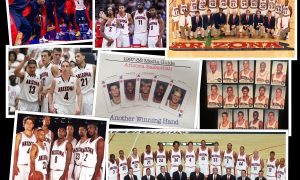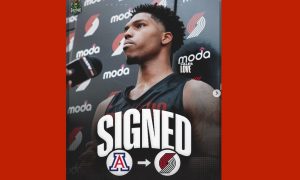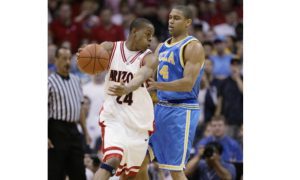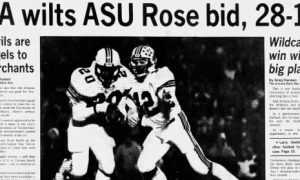|
|
|
ARIZONA PRODUCTIVITY RATING
[table “” not found /]
GLOSSARY:
G: Games played. S: Number of starts.
BP: Bench points. A player gets three points if he is first off the bench, two if second and one if third. Shows Sean Miller’s rotation.
UCLA: Productivity points against UCLA
UMIN: Minutes played against UCLA
PP: Productivity Points (Points, assists, rebounds, steals, blocked shots, FGs made, FTs made added together and then subtracted by missed FGs, missed FTs, personal fouls and turnovers)
TMIN: Minutes played overall
PR: Productivity rating per minute played (Productivity points divided by minutes played)
NOTE: Player must average at least 10 minutes a game to be listed in primary rotation
|
PAC-12 STANDINGS [table “” not found /] |
CBSSports.com’s game story of UCLA’s 74-69 win over Arizona on Saturday night reads: “UCLA surprises No. 11 Arizona” Surprises? No surprise here. UCLA was the odds-on favorite to win. Nobody on ESPN College GameDay’s crew gave the Wildcats a chance in the two-hour program earlier in the day. Although Arizona fought its way back — reminiscent of its ability to come back from deficits against Florida and Colorado in the first half of the season — the Wildcats came up short (as was expected by most) against the Bruins. It was up to the Wildcats to turn the tide of doubt and finally beat one of the Pac-12’s elite — Oregon, UCLA and Cal. The Wildcats’ record now against the conference’s top three teams is 0-4 with two of the losses at McKale Center. |
Arizona was playing for a No. 1 seed in the NCAA tournament a month ago. Now the Wildcats, 3-4 in their last seven games, are in need of a victory over ASU next Saturday to clinch the No. 4 spot in the conference and avoid having to play on the first day of the Pac-12 tournament.
Arizona is unable to capture the regular-season Pac-12 title. That’s now between Oregon, UCLA and Cal. The Bruins’ freshman-laden roster has jelled together down the stretch, while Arizona has struggled to find its rhythm from when it started 12-0.
“UCLA, they have a lot of good things going for them,” Arizona coach Sean Miller told reporters after the game. “If they win the conference, my vote for the conference player of the year is Larry Drew (II). And I don’t really think it’s close.”
Drew won the battle of the transfer point guards. Drew, with one year of eligibility after playing at North Carolina, finished with 20 productivity points in 38 minutes (for productivity points definition, see glossary). Lyons, playing for the UA for only one year after transferring from Xavier, finished with eight productivity points in 31 minutes.
In UCLA’s season sweep over the Wildcats, Drew tallied 36 productivity points in 73 minutes compared to Lyons’ 12 productivity points in 64 minutes.
Beyond any statistic is Drew’s leadership qualities, a sage veteran directing ball movement with three quality freshman starters (Shabazz Muhammad, Kyle Anderson and Jordan Adams).
At least Arizona’s bench players Grant Jerrett and Jordin Mayes provided an answer for UCLA reserve David Wear, who posted 24 productivity points in 31 minutes including 10 points, nine rebounds and two three-pointers in the second half.
Jerrett led the Wildcats with 25 points in 24 minutes returning close to his hometown of Chino Hills, Calif. Mayes, who is from Los Angeles, awoke from a season-long slumber and showed flashes of how he played during the UA’s Elite Eight season of 2010-11. He finished with eight productivity points in 13 minutes (eight points and two assists).
“I thought we played well as a team and much better than the SC game (lost by Arizona 89-78 on Wednesday),” Jerrett told reporters. “(Miller) said we played much better with more heart and more focus.”
It’s inviting and easy to second-guess Miller, berate efforts by players and question the Wildcats’ NCAA tournament worth with how they have played over the last four weeks. From my experience covering Arizona’s basketball team when Lute Olson coached, the Wildcats struggled in March when Olson and his players were uptight and not appearing to have fun in what should be the funnest time of the year.
During Arizona’s NCAA tournament run in 1997 when the Wildcats ran the table despite finishing 19-9 in the regular season, Olson was Olson Light, loose with his team without the suffocating pressure. Miller’s comments after Arizona’s loss to UCLA suggest he is trying to loosen the knot over what many fans and observers think of Arizona’s program now that the Wildcats have encountered adversity.
“It would be difficult for any team to come in here today and win,” Miller told reporters. “We battled back in the second half and to see Grant Jerrett do what he did as a freshman gives me a lot of hope here down the home stretch.”
Strange that the word “hope” was used with a team that seemed to have lost all hope when UCLA threatened to rout the Wildcats, ahead 57-44 with 13:36 remaining.
Saturday’s game is a lot more than for bragging rights against arch-rival ASU. The Wildcats will honor seniors Solomon Hill and Kevin Parrom, who have weathered the challenges of Miller re-establishing the program. Lyons will also play his last game at McKale Center, a final chance to showcase why it was a good idea that he transferred to Arizona to conclude his collegiate career.
Fun must restored back to Arizona’s program. The Wildcats have an opportunity Saturday for that at McKale Center against ASU.
Despite missing a dunk that caused a five-point turnaround (UCLA hit a three-pointer at the other end) in the second half, freshman center Kaleb Tarczewski was solid on the boards with a team-high 10 rebounds. Jerrett was next with five. Hill and Parrom had only four each. Arizona won the battle of the boards 34-29 but UCLA managed to get some key putbacks in the second half.
Defensive Rebounding Percentage (DRB%): Determined by dividing Arizona’s defensive rebounds (25 against UCLA) by the opposition’s offensive rebounds (UCLA had eight) added to Arizona’s defensive rebounds (25) — 25/(8 + 25) = 75.8 percent.
Offensive Rebounding Percentage (ORB%): Determined by taking Arizona’s offensive rebound total (nine) divided by that total (nine) and the defensive rebounds of the opponent (21 for UCLA) — 9/(9 + 21) = 30.0 percent.
Ideal marks are 72 percent DRB% and 38 percent ORB%.
|
DEFENSIVE/OFFENSIVE REBOUNDING% [table “” not found /] |
Site publisher, writer and editor Javier Morales is a former Arizona Press Club award winner
[rps-paypal]
|
|






























